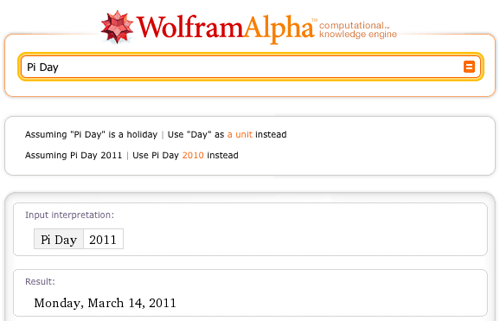 7
7
Yes, it is once again the time of the year when the mathematically inclined gather together to celebrate Pi Day…
…and, in the process, swap trivia of note on everyone’s (including Wolfram|Alpha’s) favorite number.
There have been no shortage of blog posts already written on the subject; see, for example, last year’s “Pi Day in Wolfram|Alpha” (or the Wolfram Blog Pi Day posts from 2008 or 2010). As already hinted at in last year’s blog, one would expect the pi to be ubiquitous in a computational knowledge engine—and so it is. Therefore, at the risk of beating a proven transcendental constant to death, this year we offer a few (well, OK: more than a few) additional pi-related esoterica courtesy of Wolfram|Alpha.
More »
 7
7
In my blog post last month, I wrote about Valentine’s Day in Wolfram|Alpha. Strangely, we received a number of comments indicating that the computational power of Wolfram|Alpha was not always sufficient to melt the hearts of some non-mathematically inclined sweethearts of the world. But not to fear; I have decided to persist undeterred in spite of that disappointing and surprising news, now that we’re on the verge of another holiday (and a more inherently mathematical one).
The holiday in question is Pi Day. As with a large number of other holidays, simply typing its name (in this case, “pi day”) into Wolfram|Alpha gives you basic calendrical information about it:
Now, because Wolfram|Alpha users are both intelligent and discriminating, all of you have I’m sure already noticed that when the digits in the date 3/14 (March 14 in the United States style for dates—a bit more about this later) are run together with a decimal place between, the result is 3.14. And that that decimal expansion is connected with a certain famous mathematical constant given by the ratio of the circumference of a circle to its diameter. And that little fact explains why Pi Day is celebrated on the 14th of each March. More »



